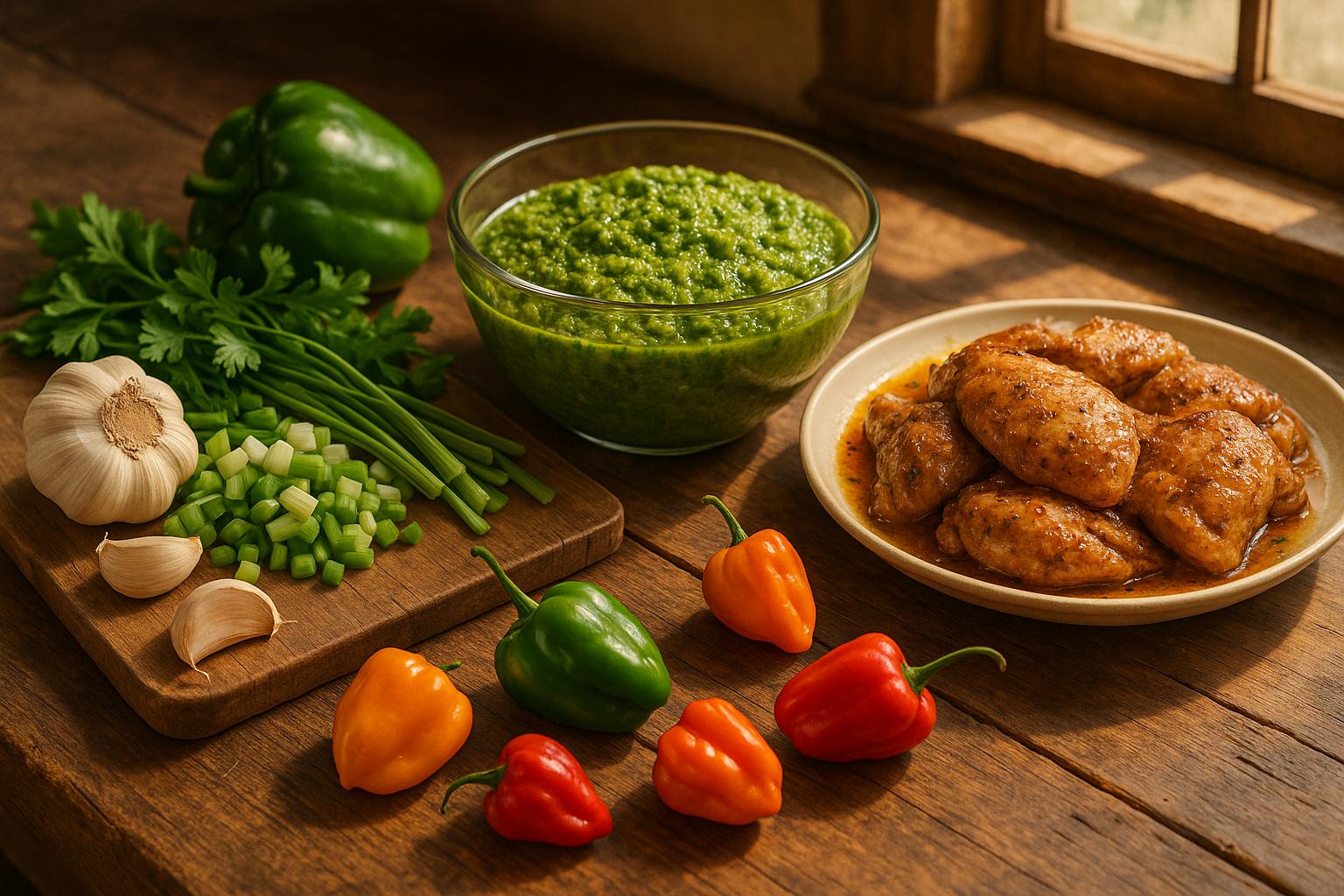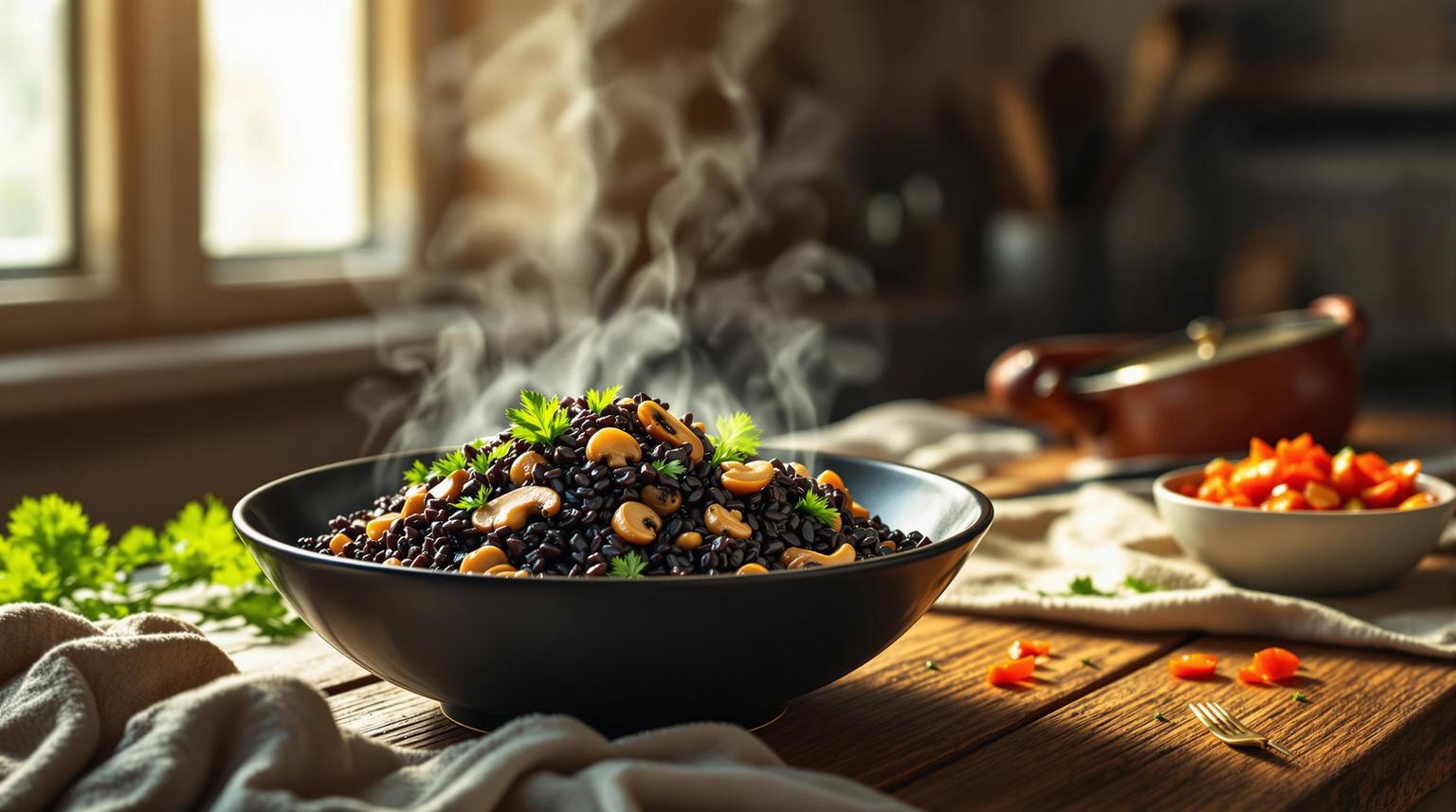Pwason nan Sos, or "fish in sauce", is a Haitian dish where fish is simmered in a rich, tomato-based sauce with herbs and spices. Unlike fried fish, this method emphasizes tender texture and deep flavor. Traditionally made with red snapper, it can also use tilapia or sea bass. The dish is a staple in Haitian culture, often served with rice, fried plantains, and pikliz. Here's a quick overview of how to prepare it:
- Ingredients: Fish, lime, Haitian epis, tomato paste, onions, bell peppers, thyme, and Scotch Bonnet pepper.
- Preparation: Clean and marinate fish with lime and epis. Simmer the sauce with tomato paste, vegetables, and spices.
- Cooking: Add marinated fish to the sauce and cook gently without flipping to maintain its structure.
- Serving: Pair with white rice, fried plantains, or rice and beans.
This dish is a flavorful representation of Haitian cuisine, perfect for family meals or special occasions.
Ingredients and Preparation
What You'll Need
To make authentic Pwason nan Sos, you'll need the following ingredients:
For the Fish:
- 2-3 lbs whole red snapper or tilapia (cleaned and scaled)
- 2-3 limes or lemons (for cleaning and marinating)
- 2-3 tablespoons Haitian epis (a seasoning base)
- 1 Maggie chicken bouillon cube
- 1 teaspoon seasoned salt
For the Sauce:
- 2 medium onions, sliced
- 1 large bell pepper, sliced
- 3-4 garlic cloves, minced
- 3 tablespoons tomato paste
- 1 Scotch Bonnet or Habanero pepper (whole, for heat)
- 2 sprigs fresh thyme
- 2 tablespoons vegetable oil
- 1 tablespoon butter
- 2-3 cups water or fish stock
- Salt and pepper to taste
Optional Seasonings:
- 1/4 teaspoon ground cloves
- 1 teaspoon garlic powder
- 1/2 teaspoon Accent (MSG)
If you're using fillets, ask your fishmonger to save the bones. They’re perfect for making a fish stock that can add incredible depth to your sauce.
Now that you have your ingredients, let’s get the fish ready.
Preparing the Fish
Properly cleaning and marinating the fish is the key to achieving the dish's rich flavors. Even if your fishmonger has done some prep, it’s worth giving the fish a final touch at home.
Start by descaling the fish thoroughly. Use a paring knife and scrape from tail to head. Remove any remaining gills and fins for a cleaner presentation and better flavor.
"When preparing fish, Haitian style, lemon or lime juice is very important. It not only adds an acidic flavor, but it also helps to further enhance the flavor of the fish and other spices that are used." - Savory Thoughts [2]
Rinse the fish inside and out with lime or lemon juice. This step not only removes any lingering fishy odor but also sets the stage for the marinade. Make diagonal cuts about an inch apart on both sides of the fish. These cuts allow the marinade to seep in and ensure even cooking.
For the marinade, mix epis, the crushed bouillon cube, lime juice, and seasoned salt. Rub this mixture generously over the fish, making sure to coat both the inside and outside. Pay special attention to the cuts you made earlier.
Let the fish marinate for at least 2 hours, or better yet, overnight for a more intense flavor. Be sure to cover and refrigerate it during this time.
Pro tip: Wear gloves while handling the fish and marinade to keep the smell from sticking to your hands.
Ingredient Swaps and Where to Find Them
If you need to make substitutions or find alternatives, here are some helpful tips:
Fish Options: While red snapper is traditional, other firm white fish like tilapia, sea bass, or cod work just as well. Whole fish delivers the best flavor, but fillets can be a quicker option for busy days.
Citrus Substitutions: If sour oranges are unavailable, mix lime juice with a splash of regular orange juice for a similar tangy-sweet effect.
Seasoning Alternatives: Haitian epis is ideal for this dish, but if you can’t find it, a good all-purpose seasoning blend will work. Look for epis at Caribbean markets or order it online. Some Haitian communities also use Jacmel or Saint Marc seasoning, but these may be harder to locate.
Adjusting Heat Levels: Scotch Bonnet peppers bring a fiery kick, but you can tone things down by using a bell pepper or a small piece of jalapeño instead. Remember, it’s easier to add heat later than to take it away.
Stock Options: Fish stock is the most authentic choice, but chicken stock or even water can be used in its place.
Most of these ingredients can be found at your local grocery store. For specialty items like epis or Scotch Bonnet peppers, check out Caribbean or international markets, or explore online retailers that offer convenient shipping options.
Cooking Instructions
Building the Sauce
The sauce is the heart of Pwason nan Sos, and getting it right is key. Start by warming 2 tablespoons of vegetable oil in a large, heavy-bottomed pan or Dutch oven over medium heat. Choose a pan wide enough to fit your fish comfortably.
Once the oil is hot, toss in your sliced onions and bell peppers. Sauté for 3-4 minutes until the onions turn translucent and the peppers soften slightly. Add minced garlic and stir for another minute, being careful not to let it burn.
Next, it's time to "bloom" the tomato paste. Push the vegetables to one side of the pan and add the tomato paste to the empty space. Cook the paste for 2-4 minutes until it deepens in color and develops a richer flavor [1]. This step removes any metallic taste and enhances the overall flavor of the sauce. Stir frequently to avoid burning.
Once the tomato paste is ready, slowly pour in 2-3 cups of water (or fish stock, if you have it) while stirring to create a smooth, lump-free sauce. Add fresh thyme sprigs and a whole Scotch Bonnet or Habanero pepper. Keeping the pepper whole allows you to enjoy its flavor without overwhelming heat.
Season the sauce with salt and pepper to your liking, then bring it to a gentle simmer. Let it cook for about 5 minutes, allowing the flavors to blend and the sauce to thicken slightly.
With your sauce prepped, you're ready to add the marinated fish.
Adding the Fish
Gently place your marinated fish into the simmering sauce, being careful not to splash or break the fish. The fish should be partially submerged in the sauce. Pour in any remaining marinade to make sure all those flavors are captured. If the liquid level is too low, add a little more water to ensure the fish is well-covered.
Here’s an important tip: Avoid flipping the fish. Instead, baste the exposed portion with the sauce every 2-3 minutes. This ensures even cooking without risking the fish falling apart.
Cook the fish for 10-15 minutes, depending on its size and thickness. You’ll know it’s ready when the flesh turns opaque and flakes easily when tested with a fork at the thickest part.
While the fish cooks, stir the sauce gently around it to prevent sticking, but be cautious not to disturb the fish itself. This helps maintain its structure while ensuring the sauce doesn’t burn.
Final Steps
As the fish nears completion, focus on perfecting the sauce. Taste and adjust the seasoning with a pinch of salt, a squeeze of lime juice, or a small spoonful of epis for extra depth.
Add 1 tablespoon of butter to the sauce in the final minutes of cooking. This step adds a luxurious silkiness that ties all the flavors together. Swirl the butter gently into the sauce.
Check the fish for doneness by inserting a fork into the thickest part. It should flake easily and appear opaque throughout. If you’re using a thermometer, the internal temperature should reach 145°F. The sauce should have a balanced consistency - not too watery or overly thick. If it’s too thin, let it simmer uncovered for a few minutes to reduce. If it’s too thick, add a splash of hot water.
Before serving, remove the thyme sprigs and the whole hot pepper unless you prefer the extra heat. These final touches ensure the dish highlights the vibrant Haitian spices and techniques that make Pwason nan Sos so special.
"You will find that the seasoning and preparation is extremely similar to the 'Pwason Fri' recipe that has been previously posted. The main difference is that this one isn't fried. I hope you give this one a try as it's full of flavor and very delicious!" - Suzon Spice [1]
Your Pwason nan Sos is now ready to serve. The fish should be tender and infused with the aromatic sauce, while the sauce itself should be rich and perfectly balanced. All that’s left is to plate and enjoy this incredible Haitian dish!
How to make Pwason nan Sos (Fish in sauce) - Episode 43 -❤ Love For Haitian Food

sbb-itb-80c33ff
How to Serve Pwason Nan Sos
Once your Pwason nan Sos is simmered to perfection, it's time to serve it in a way that honors its Haitian roots.
Best Side Dishes
The classic pairing for Pwason nan Sos is white rice. Its simplicity allows the rich, flavorful sauce to shine, soaking up every drop to create a harmonious balance with the fish.
Another favorite is fried plantains (bannann peze). Their crispy edges and soft, sweet interiors make them a delightful contrast to the dish. Adding avocado to the plate brings a creamy element that pairs beautifully with the sauce.
For a spicy twist, serve pikliz - a tangy, spicy pickled vegetable mix. Its acidity cuts through the richness of the sauce, adding a vibrant kick.
If you're looking for something heartier, try diri ak pwa (rice and beans), a filling alternative to plain rice. You can also serve sos pwa (bean purée) on the side for those who enjoy an extra layer of flavor.
Other Haitian staples like boiled plantains (bannann bouyi) or Salade Russe (a Haitian-style potato salad) are also excellent choices. In fact, a blog post from Love For Haitian Food [3] suggests pairing Diri Blan (white rice) with Salade Russe for a delicious combination.
Plating Tips
The sides you choose not only enhance the flavors but also offer room for creative presentation.
Family-style serving is a popular option in Haitian homes. Place the fish in a central dish or pan, allowing everyone to serve themselves. This approach fosters a warm, communal atmosphere and keeps the dish warm for longer.
For individual plating, start by placing a scoop of white rice on one side of the plate. Add a piece of fish next to it, then generously spoon the sauce over both the fish and rice to tie the flavors together.
To elevate the presentation, garnish with fresh thyme, lime wedges, or a small portion of pikliz. These touches add a burst of color and an extra layer of flavor. Be sure to keep the fish visible - its golden-brown exterior creates a beautiful contrast against the reddish-brown sauce. Avoid drowning the fish completely in the sauce to maintain its visual appeal.
Serve everything hot, with all sides warmed and ready to enjoy.
Storage and Leftovers
To keep the rich, bold flavors of this Haitian dish intact, proper storage is key. Interestingly, leftovers often taste even better as the ingredients blend over time. Follow these tips to enjoy your dish for days to come.
How to Store
Place the fish and sauce in an airtight container within two hours of cooking - leaving fish out any longer isn't safe. According to the FDA, seafood should be stored in a refrigerator set at 40°F (4°C) or below [6][7]. Properly stored leftovers will stay fresh for 3 to 4 days [4]. For longer storage, freeze the dish for up to three months. Use airtight containers or freezer-safe bags, and don’t forget to label them with the date [6].
Before reheating or eating leftovers, check for spoilage. Signs like a strong, unpleasant smell, dry texture, or visible mold mean it’s time to throw it out [5].
Once stored, reheating the dish correctly can make all the difference.
Reheating the Dish
When reheating fish, a gentle touch is essential to maintain its texture and flavor. Steer clear of the microwave, as it tends to dry out the fish [8][9]. Instead, try these methods:
- Oven reheating: Preheat the oven to 275–350°F (135–177°C). Place the Pwason nan Sos in a baking dish, add a bit of water or sauce to keep it moist, and cover tightly with foil. Heat for 10–15 minutes, checking occasionally [8][10].
- Stovetop reheating: Warm the dish in a skillet or saucepan over low heat. Add a splash of broth or sauce, cover, and stir occasionally until heated through [10].
- Toaster oven: Wrap the dish in foil and set the oven to 275–350°F (135–177°C). Heat until it reaches your desired temperature, checking often [8][9].
Adding moisture and covering the fish during reheating helps preserve its original texture. Keep in mind, reheated fish may have a slightly different taste compared to when it was freshly cooked [9].
If you're feeling creative, turn leftovers into something entirely new.
Using Leftovers
Leftover Pwason nan Sos can be repurposed into fresh, delicious meals. For instance, make fish tacos by warming up corn tortillas, flaking the fish, and adding the sauce. Top with fresh cilantro, diced onions, and a squeeze of lime for a zesty twist. Another idea is to use the fish and sauce as a base for a seafood stew [9][11].
Thicker cuts of fish hold up better to repurposing, as they retain more moisture [8][9]. With a little imagination, leftovers can feel like an entirely new dish!
Conclusion
Making Pwason nan Sos at home is a wonderful way to bring the flavors of Haitian cuisine into your kitchen. The process is simple but rewarding: start by cleaning and marinating your fish with epis and seasonings for at least two hours or overnight, create a flavorful tomato paste-based sauce, and then gently cook the fish while basting to keep it moist. Be careful when handling the fish to prevent it from breaking apart, and always taste and adjust your seasonings before serving.
This dish beautifully captures the heart of Haitian cooking - transforming simple ingredients into bold, comforting flavors. It pairs perfectly with rice and vegetables, making it a meal that’s as satisfying as it is flavorful.
Pwason nan Sos is more than just a recipe; it’s a reflection of Haiti’s rich culinary heritage, shaped by African, French, Spanish, and Taíno influences [12][13]. As culinary expert Sam Oriach explains:
"Haitian food is more than just a meal. It's a living history." [12][13]
Once you’ve mastered this dish, you might want to explore other Haitian favorites like Griyo, a beloved pork dish; Diri djon djon, made with uniquely flavored black mushrooms; or Soup Joumou, a powerful symbol of Haitian independence. Each of these dishes tells its own story of resilience, community, and pride, connecting generations through the shared experience of food.
If you’re eager to delve deeper into Haitian cooking, HaitianFoods.org is an excellent resource, offering a treasure trove of traditional recipes and tips on where to find authentic Haitian flavors. Start with simple recipes like Pwason nan Sos, and as your confidence grows, tackle more complex dishes to fully appreciate the depth and richness of Haiti’s culinary traditions. With every step, from marinating to slow simmering, you’ll be bringing these authentic techniques to life in your own kitchen.
FAQs
What is Haitian epis, and how can I make it at home if I can’t find it in stores?
Haitian epis is a vibrant seasoning blend packed with fresh herbs, vegetables, and spices. It’s a cornerstone of Haitian cuisine, bringing bold flavor to dishes like soups, stews, and rice.
Can’t find epis at your local store? No problem - you can whip it up at home with ease. Combine garlic, parsley, cilantro, green onions, bell peppers, thyme, scallions, and, if you like some heat, Scotch bonnet peppers. Blend these ingredients with olive oil, salt, and pepper until you have a smooth paste. Store it in an airtight container in your fridge, and you’ve got a versatile base to elevate your cooking.
Can I use frozen fish to make Pwason nan Sos, and what should I do differently?
Yes, you can absolutely use frozen fish to prepare Pwason nan Sos. For the best outcome, make sure to thaw the fish completely in the refrigerator before marinating and cooking. Thawing helps the fish soak up the flavors evenly and ensures it cooks just right.
If you're pressed for time and need to cook the fish while it's still frozen, simply increase the cooking time by about 50%. Be sure to check that the fish is fully cooked before serving to achieve the ideal texture and flavor.
How can I make Pwason nan Sos less spicy without losing its authentic flavor?
If you want to tone down the spiciness of Pwason nan Sos without losing its signature taste, consider using less Scotch Bonnet pepper or skipping it altogether. For a milder alternative, swap it out with green bell peppers. This way, you can keep the dish's depth of flavor intact while making it more enjoyable for those who prefer less heat.


